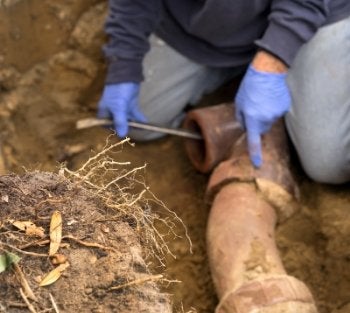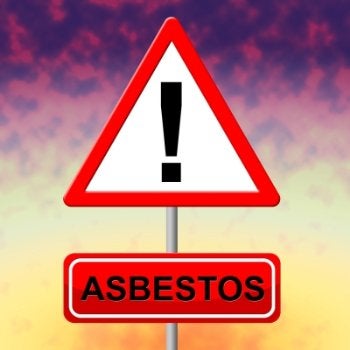-
Where Asbestos May Be Found
Asbestos symptoms can be dangerous and deadly, and asbestos testing in San Francisco may be necessary to limit your risk of asbestos exposure. This hazardous material can be found in many different places, such as auto parts, cement, tiles, and textiles that were manufactured prior to 1980. The most common site of asbestos exposure is in homes, apartment buildings, and businesses that were built before 1980.
Watch this video to learn more about how and where asbestos exposure is most likely to occur. Anyone who lives, works, or frequently visits a building that contains asbestos is at risk for asbestos exposure and asbestos symptoms.
-
Signs That Your Sewer Line May Be Clogged
A sewer line clog can cause raw sewage to back up into the drains of your home, creating an unhealthy and unsafe environment. If you suspect that you have a clogged sewer line, or if you’ve recently performed raw sewage remediation in your home, it may be necessary to perform bacteria testing in San Francisco to ensure that no harmful bacteria are present. Here are the most common signs that your sewer line may be clogged, and that bacteria testing may be necessary.
Raw Sewage Backup

The most telling sign of a sewer line clog is a backup of raw sewage into your drains. If your main sewer line is blocked, the water, paper products, and waste won’t be able to travel down your sewer line. If you flush your toilet, the sewer line backup will cause raw sewage to bubble up through your shower or bathtub drain. If you use your washing machine, your shower drain or toilet will begin overflowing. If you run your bathroom sink, your toilet water may begin to rise and bubble up. This raw sewage puts you and your family at risk of significant health problems such as mold symptoms, as it harbors dangerous bacteria that can become airborne, or may infect you through physical contact. This is why it’s crucial that you consult an expert for bacteria testing both before and after raw sewage remediation.Multiple Drains Are Clogged at Once
Another warning sign of a sewer line clog is that multiple drains in your home will become clogged at the same time. Your toilet, bathtub, and shower will all either drain very slowly, or won’t drain at all, causing flooding and overflows. If your drains are all clogged and plunging or snaking them doesn’t provide relief, then you probably have a clogged sewer line.Strange Sounds and Odors Throughout Your Home
A sewer line clog will cause your drains to consistently make gurgling or bubbling sounds when plumbing is used. You will also notice a strong smell of sulfur or general noxious odors throughout your home. Mold symptoms are another common sign of plumbing problems. -
A Look at the History of Lead Paint
The use of lead paint in San Francisco began during Colonial times, and peaked in 1922. At the time, there was little knowledge of the danger of lead exposure and lead poisoning symptoms. Because lead paint was durable and washable, the interiors of many buildings and homes contained lead paint. By 1951, lead testing revealed the dangers of prolonged exposure to lead paint.
The first city to ban the use of lead paint was Baltimore, in 1951. By 1955, public health officials developed a national standard that allowed manufacturers to voluntarily limit their usage of lead in their interior paint. This caused a significant decline in the manufacture and use of interior and exterior lead paint throughout the 1950s and 1960s.
In 1971, the government passed the Federal Lead Poisoning Prevention Act. It wasn’t until the late 1970s that lead surveys and lead paint testing confirmed that lead poisoning symptoms could be caused by exposure to household dust. In 1978, the federal government banned the consumer use of lead paint. Homes and buildings constructed prior to 1978 should undergo thorough lead surveys and lead paint testing to ensure that they are safe.

-
Answers to Your Questions About Asbestos
If you work or live in a building that was constructed before 1980, you may be at risk of asbestos exposure in San Francisco . Today, asbestos exposure is a known cause of many illnesses and diseases, and asbestos use is banned or severely restricted in most countries. Here are the answers to some frequently asked questions about asbestos.
What is Asbestos?
Asbestos is a naturally occurringmineral in the earth. It’s known for its strength, insulating power, heat

resistance, and versatility. According to the Environmental Protection Agency, there are six different types of asbestos that were once used in automotive parts, tiles, cement, and textiles. Almost 90% of the asbestos that was used to produce these products was chrysotile asbestos. Manufacturers began using asbestos in the 1800s and it wasn’t until the 1970s that the world became fully aware of its dangers. Now, products can only contain 1% of asbestos in order to be considered safe.
How Does Asbestos Exposure Occur?
There are 75 different jobs in America that are known to expose employees to asbestos. The majority of cases of asbestos exposure occur on the job, but there are also homes and apartments that still contain asbestos. Asbestos can be found in the floor tiles, roofs, furnaces, plumbing, appliances, fireplaces, and window caulking of buildings constructed before the 1980s. Asbestos exposure occurs when normal wear and tear dislodges asbestos fibers, allowing them to become airborne. Anyone in the room or building is at risk for breathing in the fibers and suffering from asbestos exposure.What Are the Dangers of Asbestos Exposure?
Asbestos exposure is practically the sole cause of mesothelioma, a rare and aggressive form of cancer. Asbestos exposure is also linked to lung cancer, pleural mesothelioma, peritoneal mesothelioma, pericardial mesothelioma, and asbestosis. Asbestos symptoms typically don’t show up until about ten to forty years after asbestos exposure occurs. The most common asbestos symptoms are a persistent cough, shortness of breath, loss of appetite, weight loss, chest tightness or pain, and clubbing of the fingertips or toes.
RECENT POSTS
categories
- Uncategorized
- Lead
- Mold
- San Francisco Mold & Asbestos Removal
- Indoor Air Pollution
- Mold Remediation
- Asbestos
- Safe Air Fast
- Mold Inspection
- Remediation
- Bacteria Testing
- Asbestos Testing
- Abatement
- Lead Testing
- Sewer Line
- Lead Survey
- Mold Testing
- Air Quality Inspection
- Home renovations
- Allergies
- Renovation Contractor
- Infographic
- lead paint
- Air Quality
- Air Quality Test
- Mold removal
